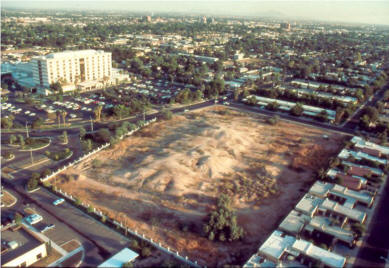[Source: Arizona Republic; by Kathleen Ingley, columnist]
The mission known as “The White Dove of the Desert” shimmers with the unworldly glow of a mirage in the dry flatlands south of Tucson .
.

San Xavier del Bac, with its asymmetrical towers, elegant curves and exuberant decoration, is the best example of Spanish colonial architecture in the nation. It’s such an important window into the past that it was one of the original listings when the National Register of Historic Places was established in 1966.
But the White Dove is in danger.
The Legislature drained the Heritage Fund, wiping out a $150,000 grant that was supposed to help pay for repairing the east tower. The job was the final part of a two-decade restoration project. Without it, the tower and the entire structure are at risk.
Go to San Xavier, and you can’t miss the problem. The mission’s two towers look like “before” and “after” pictures for plastic surgery.
The west tower has brilliant-white stucco, new balustrades, reworked volutes and a reconstructed balcony made with mesquite.
The shorter east tower, which doesn’t have a cupola, is dingy, chipped and mottled with black mold stains. Parts of the finials and cornices are loose and could come crashing to the ground.
The Revolutionary War had just officially ended and southern Arizona was still part of New Spain when construction started on Mission San Xavier in 1783. The structure, made from fired-clay bricks in an unusual series of 11 domes, has the fluidity and openness of the Spanish baroque style.
Thanks to a series of factors, including a 50-year abandonment, isolation and scarce resources for making major changes, the mission has remained relatively unaltered since it was built. Architect Bob Vint, who has worked on the restoration, calls it “a time capsule.”
Virtually all the art inside, which has been cleaned by an international team of conservators, dates from the late 1700s. The sculptured-plaster altar is covered in gold and silver leaf.
The mission, which sits on the San Xavier Tohono O’odham Reservation, still functions as a parish church. But the building itself is a cultural monument and a major tourist attraction, drawing about 200,000 visitors a year from around the world.
In an ironic twist, most of today’s problems come from past efforts at restoration. The exterior was coated with concrete in a misguided attempt to protect the mission. But the concrete ended up trapping moisture, melting away the centuries-old bricks.
The current restoration project strips off the concrete and goes back to the original way the mission was built. The bricks for it are produced in Mexico using a traditional process – including a mule-powered mill to sift sand out of the clay – to match the mission’s bricks in density, porosity and salt content. The mortar is mixed with local sand and lime, plus a natural glue made from cactus pads.
The Patronato San Xavier, a non-profit that promotes the mission’s conservation, has managed to keep the restoration rolling with a combination of fundraising and grants.
The west tower was finished in 2009, and the scaffolding was about to go up on the east tower when word came that the Heritage Fund grant was in jeopardy.
We are not talking enormous sums of money. The Heritage Fund has put in $230,000 over the course of 15 years.
The current grant was just $150,000. But it would have triggered an equal amount of matching money and provided a solid base for starting the east tower project. The total cost is estimated at $1.5 million.
Voters established the Heritage Fund in 1990, dedicating money from the state Lottery to several grants programs for recreation and historic preservation. But the Legislature has been raiding that part of the Heritage Fund for the past three fiscal years, taking a total of $26.3 million.
The San Xavier grant was canceled. And there’s no prospect of getting it back. Lawmakers quietly abolished the cultural and recreational portion of the Heritage Fund.
Interestingly, the part of the Heritage Fund that is administered by the Arizona Game and Fish Department has taken hits in the past but didn’t fall victim to this year’s budget crisis. Maybe advocates of culture and history would be more persuasive if they carried rifles and fishing rods.
San Xavier’s restoration should have been finished in time for Arizona’s centennial in 2012.
That’s impossible now. But it would be a disgrace not to have the work well under way on the state’s 100th birthday.
We’re in a real race against time.
“That east tower is deteriorating,” says Vern Lamplot, executive director of the Patronato. “The longer it sits, the more damage is done to it, which ultimately threatens the whole thing.”
These are tough times for fundraising. But the remaining cost of restoring this irreplaceable piece of Arizona’s history and culture is remarkably small. It’s inconceivable that Arizonans won’t raise it.
Reach Ingley at kathleen.ingley@arizonarepublic.com or (602) 444-8171.



You must be logged in to post a comment.